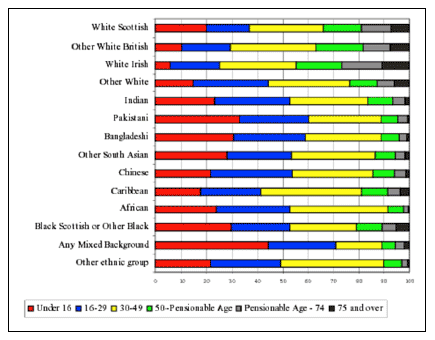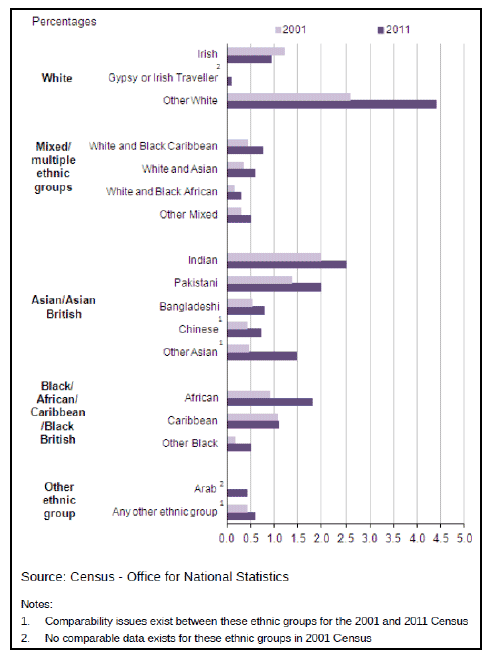Scottish Government Equality Outcomes: Ethnicity Evidence Review
This evidence review was prepared to support the production of the Scottish Government's Equality Outcomes, with regard to ethnicity.
2 Context
Legal definition in the Equality Act (2010)
2.1 The EHRC's guidance for the Equality Act 20101 gives the following definition of the protected group for race: "Race… refers to a group of people defined by their race, colour, and nationality (including citizenship), ethnic or national origins". The terms "race" and "ethnicity" are both used in this definition and in the evidence that has been reviewed, and will be considered to be interchangeable for the purposes of this paper.
2.2 In this paper we have used the terminology that was used in the evidence under review. We have defined terms, where definitions were provided by the authors of the evidence. Where the evidence gives detailed ethnic subgroups (e.g. white Scottish, white British, white Irish, white other), these are repeated in the text. Where the evidence makes no such distinction, the broader descriptors used (e.g. white people) are also repeated here.
2.3 Regarding the availability of data, we have provided as much detail as is available on individual ethnic groups. We have also included specific evidence relating to Gypsies/Travellers, asylum seekers and refugees in Scotland where it is available, to ensure that their specific outcomes and experiences are reflected in this review. Small sample sizes mean that robust quantitative analysis of data for different ethnic groups is not always possible, so some researchers have chosen to combine ethnic groups, or multiple years' worth of data, or both, in order to be able to analyse the available data. Where researchers have combined ethnic groups, they have constructed groups and use specific terms to describe the populations they are analysing. These specific terms are not always defined, but examples include white (which we understand to be a composite of all the white sub-groups), white other (which is usually defined in opposition to listed white groups, and so depends on the context), non-white or visible minority (all ethnic minorities excluding all white groups), Asian (including the countries of the Indian sub-continent), and A8 (the eight European Union accession countries subject to the Worker Registration Scheme in 2004: the Czech Republic, Estonia, Hungary, Latvia, Lithuania, Poland, Slovakia, and Slovenia).
2.4 Regarding the inclusion of Gypsies/Travellers as an ethnic group, the EHRC report Gypsy Traveller Accommodation in Scotland2 regards Scottish Gypsies/Travellers (including ethnic Gypsies and Irish Travellers) as a racial group in the context of equalities. For the purposes of this review, all three will be included in the Gypsy/Traveller group.
2.5 It should be noted that some of the data sources cited in this Evidence Review cover the whole of the UK and so are not specific to Scotland. This will be pointed out in the text.
Demography
2.6 The most robust data source we have at present is the 2001 Census; data from the 2011 Census are expected to become available later this year.
2.7 The 2001 Census reported the ethnic minority population as 2.01% of the Scottish population, or 101,746 people3. Pakistanis were the largest ethnic minority group, followed by Chinese, Indians and those of mixed ethnic backgrounds. Over 70% of the total ethnic minority population were Asian: Indian, Pakistani, Bangladeshi, Chinese or other South Asian. Over 12% of the ethnic minority population described their ethnic group as mixed.
2.8 The size of the ethnic minority population has increased since the 1991 Census. Whilst the total population increase between 1991 and 2001 was 1.3%, the ethnic minority population increased by 62.3%. Figure 1 shows that the minority population generally has a younger age profile than the white population.
Figure 1: Ethnic and age composition of Scotland's population in 2001, %. (Source: Census, 2001)

2.9 The ethnic minority population in Scotland is distinctive within the UK in terms of size, ethnic composition and patterns of settlement4. It includes Pakistanis, Chinese, Indians and Africans, A8 migrants, Gypsies/Travellers, asylum seekers and refugees, Irish Catholics and other communities. These groups are concentrated in the four main cities of Glasgow, Edinburgh, Aberdeen and Dundee, with the highest concentration in Glasgow (5.5 %). There is also quite a high proportion of ethnic minorities in the affluent suburban districts adjacent to Glasgow (East Renfrewshire and East Dunbartonshire), suggesting an element of established or 'middle-class' ethnic minority groups. Neighbourhood concentrations are rare, compared with the situation in England, with Glasgow being the only exception (where one ward has 48%, and three other wards with more than 20%).
2.10 The Annual Population Survey provides up to date information about the characteristics of people living in Scotland. Table 15 shows that since 2004, the proportion of the population in Scotland who reported their ethnicity as white has fallen from 97.7% to 96.7%, while the proportion of the population who reported their ethnicity as mixed, black or black British, or Chinese has increased over the same period. The proportion of people who reported their ethnicity as Asian or Asian British has increased from 1.2% to 1.6% since 2004, and remains the second largest ethnic grouping within Scotland.
Table 1: Population profile by ethnicity, Scotland, 2004-2009 (Source: Annual Population Survey)
| White | Mixed | Asian or Asian British | Black or BlackBritish | Chinese | Other | All | |||||||
|---|---|---|---|---|---|---|---|---|---|---|---|---|---|
| Proportion | Level | Proportion | Level | Proportion | Level | Proportion | Level | Proportion | Level | Proportion | Level | Level | |
| 2004 | 97.7% | 4,897,700 | 0.4% | 20,200 | 1.2% | 56,900 | 0.2% | 7,800 | 0.2% | 11,000 | 0.3% | 16,300 | 5,014,000 |
| 2005 | 97.5% | 4,904,700 | 0.3% | 16,100 | 1.2% | 62,500 | 0.1% | 7,400 | 0.4% | 22,500 | 0.3% | 15,200 | 5,029,700 |
| 2006 | 97.4% | 4,919,200 | 0.4% | 22,113 | 1.3% | 66,600 | 0.2% | 11,900 | 0.3% | 17,100 | 0.3% | 15,700 | 5,054,600 |
| 2007 | 97.2% | 4,937,700 | 0.4% | 20,706 | 1.4% | 73,600 | 0.3% | 14,900 | 0.4% | 20,400 | 0.2% | 11,500 | 5,080,900 |
| 2008 | 97.1% | 4,958,300 | 0.5% | 24,589 | 1.3% | 63,900 | 0.4% | 19,100 | 0.5% | 25,200 | 0.3% | 13,100 | 5,105,000 |
| 2009 | 96.7% | 4,954,600 | 0.6% | 28,351 | 1.6% | 82,500 | 0.4% | 18,500 | 0.3% | 15,800 | 0.4% | 22,400 | 5,124,600 |
2.11 The Annual Population Survey also provides information about national identity. Respondents are asked how they would describe their national identity and can choose multiple identities. Table 2 shows the results for 2009, which show that 77.4% of the population described their national identity as Scottish, and 23.0% of the population described their national identity as British.
Table 2: Population profile by national identity, Scotland, 2009 (Source: Annual Population Survey)
| National Identity | Proportion | Level |
|---|---|---|
| Scottish | 77.4% | 3,966,900 |
| English | 2.7% | 138,200 |
| Irish | 0.8% | 38,800 |
| Welsh | 0.2% | 11,800 |
| Other | 4.6% | 237,100 |
| British | 23.0% | 1,176,500 |
2.12 The Ethnicity and National Identity in England and Wales6 report from the 2011 census shows changes in the ethnic composition of England and Wales between 2001 and 2011 (see Figure 2). The category 'Gypsy or Irish Traveller' accounted for 58,000 usual residents (0.1% of the population), making it the smallest ethnic category recorded on the census in 2011. Over the last two decades England and Wales have become more ethnically diverse, although caution is needed when comparing census ethnic data over the years due to changes in how the ethnicity question was worded and in the available responses. Examination of the detailed ethnic groups shows how ethnic diversity in England and Wales has changed:
- The 'any other white' category had the largest increase across the ethnic groups, with an increase of 1.1 million (1.8 percentage points) between the 2001 and 2011 Censuses. This includes people with Poland as a country of birth, who were the second largest group of non-UK born residents in 2011 and increased by 0.5 million (a nine-fold increase) between 2001 and 2011.
- The Asian/Asian British ethnic group categories had some of the largest increases between the 2001 and 2011 Censuses. People identifying as Pakistani and Indian each increased by around 0.4 million (0.5 percentage points and 0.6 percentage points respectively).
- The remaining ethnic groups each showed small increases of up to 1%.
Figure 2: Ethnic Groups, 2001 - 2011, England and Wales (Source: Ethnicity and National Identity in England and Wales, 2012)

Contact
Email: Social Research
There is a problem
Thanks for your feedback